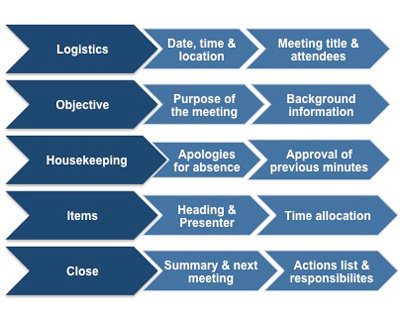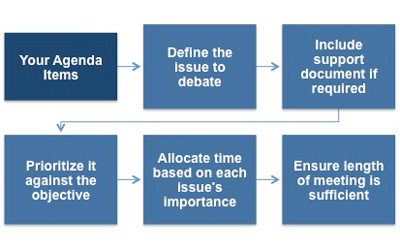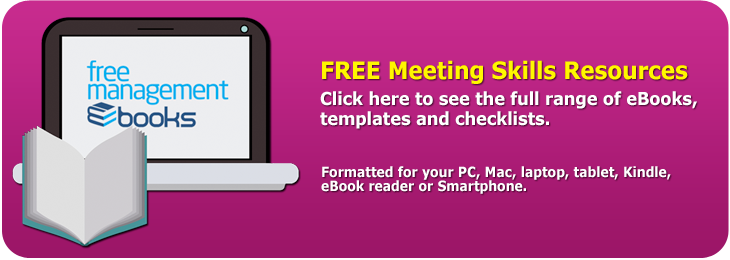Writing a Meeting Agenda
To ensure that your meeting agenda attains its five purposes it should broadly follow the lines recommended below.
 |
Logistics
Your meeting agenda should have a meaningful title as its heading, followed by the date, time, and location of your meeting. Below these details you should list the confirmed attendees.
All these details inform everyone when and where they need to be and why they will be attending.
Objective
Next you clearly state the objective of the meeting so that no one is in any doubt as to what the meeting's aims are. You will also motivate them to attend because they see a true purpose to the meeting. By prominently positioning your objective attendees can clearly see why they have been invited to attend and what preparation is necessary for them to make valued contributions.
This logical statement enables attendees to understand the reasoning behind the agenda items and is persuasive in gaining their agreement to come to your meeting. Without it, your list of discussion items would appear haphazard and lacking logic.
To add further substance to your objective your agenda should detail any background documents that form an essential part of the discussions, and where necessary you should attach them to the agenda.
It is vital that this documentation be summarized information or an overview of a certain aspect forming a key support to all attendees. This information must not be an onerous burden; all items must add value in terms of the understanding they would bring to the reader. Ensure your meeting chair brings sufficient copies of the final agenda and previous minutes so that all attendees have sight of a copy.
Housekeeping
Your meeting agenda will then detail other obligatory details: firstly, a list of all those who have sent their apologies or who have named an authorized stand-in. If any of these individuals have feedback on any particulars relating to the last meeting they will be made known to the meeting when the Chair formally asks for approval of the previous meeting.
This formal process details any amends, which are accepted or rejected by all those present as an accurate representation of that meeting. The Chair and any other required personnel will officially sign the previous minutes and a copy is filed according to the legal requirements of your organization or industry.
Items
Your agenda items must be numbered so that people can see the order of discussion and follow the logical process drawn out so that the meeting objective can be attained. The Chair, who offers a short overview to ensure all attendees are working at the same level of understanding, should present each item. The Chair will also introduce any speaker as required in this introduction.
As part of the introduction the Chair should formally remind everyone of the allotted time for the items as shown on your agenda. You will share out the available meeting time between your items in terms of their importance and priority in terms of the meeting objective and your organization.
 |
This is one of the most important mechanisms the Chair will use to control the flow of the meeting discussions. It also discourages attendees from spending too much time on trivial or non-contentious items.
Close
Finally the Chair will summarize the decisions and list of actions that have been agreed during the meeting. This item is a vital aspect and will indicate how well your objective has been achieved. It is an excellent way to ensure that all key resolutions have been noted as part of the minutes.
The Chair will thank everyone for their contribution and let them know when they can expect to receive the minutes, formally closing the meeting. This must be done swiftly so that those with actions have sufficient time to perform them.
This Meeting Agenda Checklist outlines the five key areas you need to address to produce an effective agenda. This Meeting Action List Template enables you to record actions, responsibilities and timescales that result from the meeting.
You may also be interested in:
Meeting Agenda Format | Meeting Agenda Sample | Agendas for Short Meetings.



